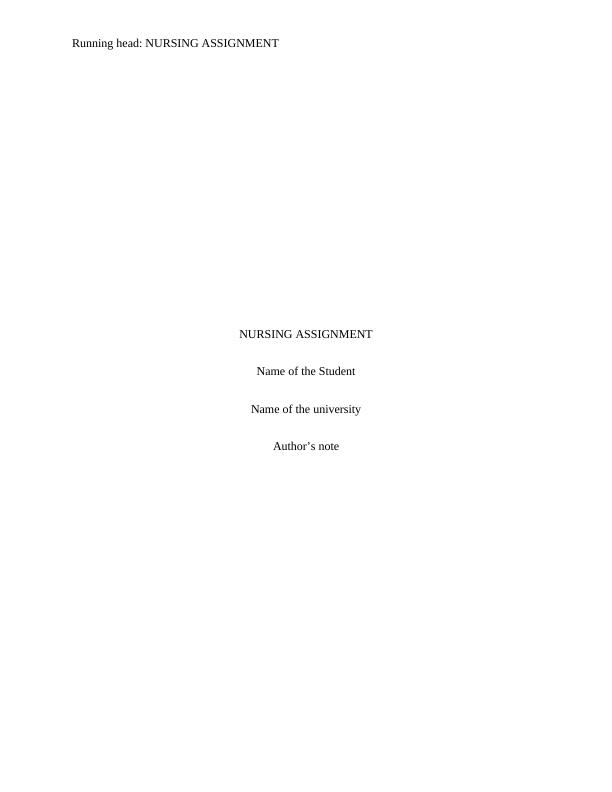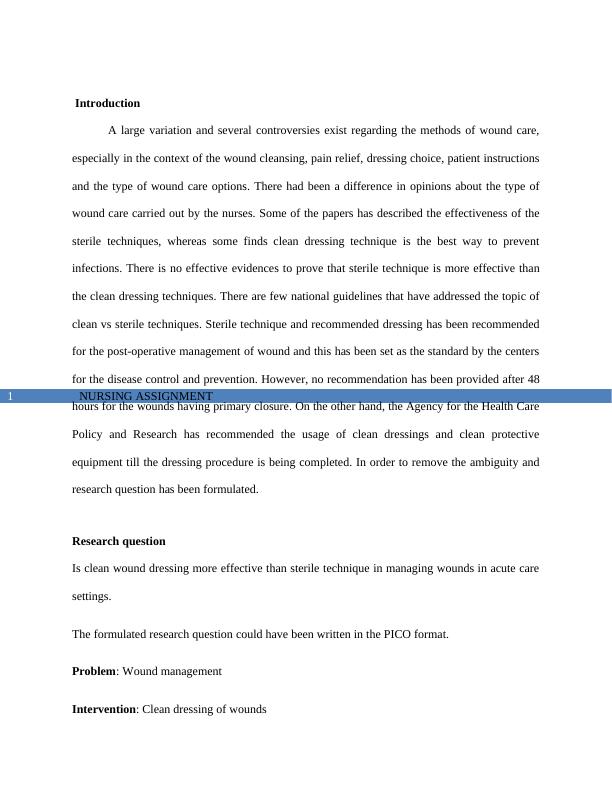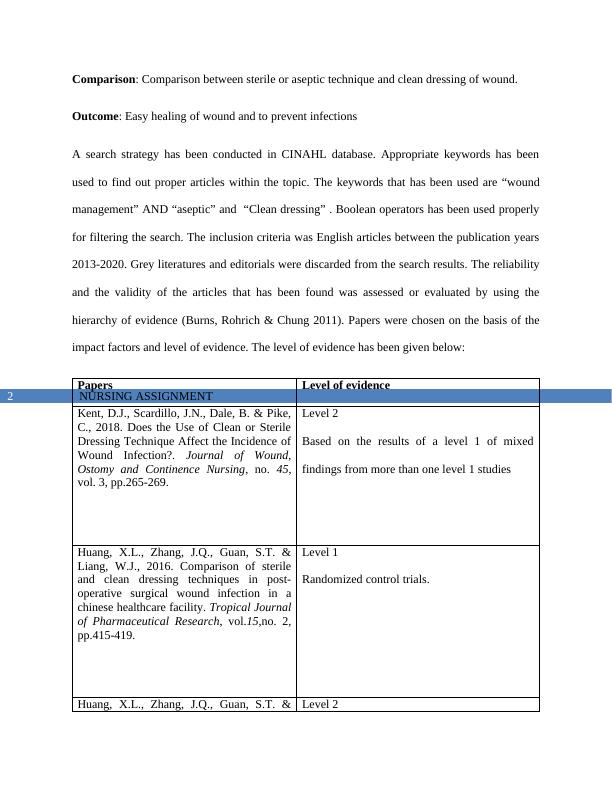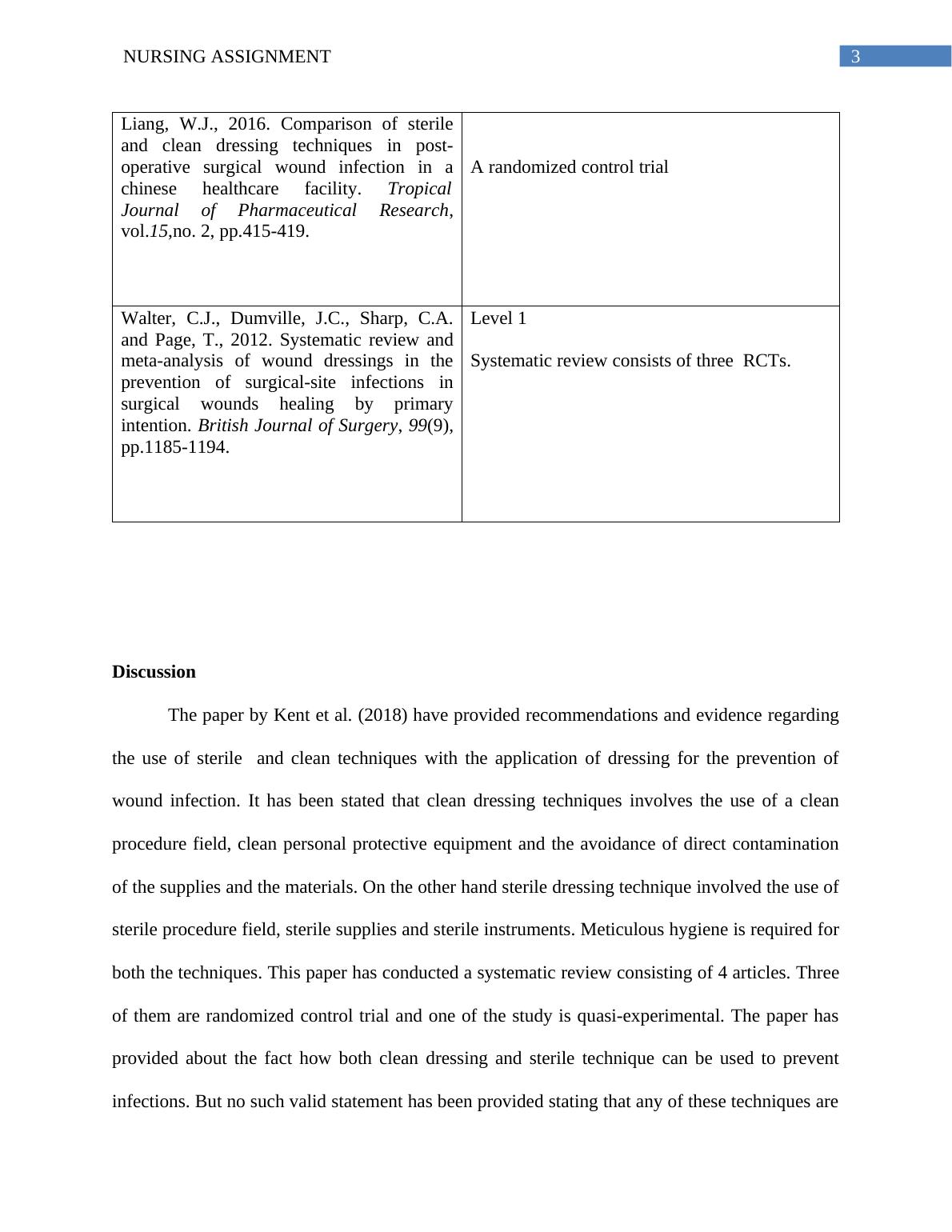Wound Management | Nursing Assignment
Using evidence to inform clinical decision making in nursing
12 Pages1829 Words21 Views
Added on 2022-08-26
Wound Management | Nursing Assignment
Using evidence to inform clinical decision making in nursing
Added on 2022-08-26
ShareRelated Documents
Running head: NURSING ASSIGNMENT
NURSING ASSIGNMENT
Name of the Student
Name of the university
Author’s note
NURSING ASSIGNMENT
Name of the Student
Name of the university
Author’s note

NURSING ASSIGNMENT1
Introduction
A large variation and several controversies exist regarding the methods of wound care,
especially in the context of the wound cleansing, pain relief, dressing choice, patient instructions
and the type of wound care options. There had been a difference in opinions about the type of
wound care carried out by the nurses. Some of the papers has described the effectiveness of the
sterile techniques, whereas some finds clean dressing technique is the best way to prevent
infections. There is no effective evidences to prove that sterile technique is more effective than
the clean dressing techniques. There are few national guidelines that have addressed the topic of
clean vs sterile techniques. Sterile technique and recommended dressing has been recommended
for the post-operative management of wound and this has been set as the standard by the centers
for the disease control and prevention. However, no recommendation has been provided after 48
hours for the wounds having primary closure. On the other hand, the Agency for the Health Care
Policy and Research has recommended the usage of clean dressings and clean protective
equipment till the dressing procedure is being completed. In order to remove the ambiguity and
research question has been formulated.
Research question
Is clean wound dressing more effective than sterile technique in managing wounds in acute care
settings.
The formulated research question could have been written in the PICO format.
Problem: Wound management
Intervention: Clean dressing of wounds
Introduction
A large variation and several controversies exist regarding the methods of wound care,
especially in the context of the wound cleansing, pain relief, dressing choice, patient instructions
and the type of wound care options. There had been a difference in opinions about the type of
wound care carried out by the nurses. Some of the papers has described the effectiveness of the
sterile techniques, whereas some finds clean dressing technique is the best way to prevent
infections. There is no effective evidences to prove that sterile technique is more effective than
the clean dressing techniques. There are few national guidelines that have addressed the topic of
clean vs sterile techniques. Sterile technique and recommended dressing has been recommended
for the post-operative management of wound and this has been set as the standard by the centers
for the disease control and prevention. However, no recommendation has been provided after 48
hours for the wounds having primary closure. On the other hand, the Agency for the Health Care
Policy and Research has recommended the usage of clean dressings and clean protective
equipment till the dressing procedure is being completed. In order to remove the ambiguity and
research question has been formulated.
Research question
Is clean wound dressing more effective than sterile technique in managing wounds in acute care
settings.
The formulated research question could have been written in the PICO format.
Problem: Wound management
Intervention: Clean dressing of wounds

NURSING ASSIGNMENT2
Comparison: Comparison between sterile or aseptic technique and clean dressing of wound.
Outcome: Easy healing of wound and to prevent infections
A search strategy has been conducted in CINAHL database. Appropriate keywords has been
used to find out proper articles within the topic. The keywords that has been used are “wound
management” AND “aseptic” and “Clean dressing” . Boolean operators has been used properly
for filtering the search. The inclusion criteria was English articles between the publication years
2013-2020. Grey literatures and editorials were discarded from the search results. The reliability
and the validity of the articles that has been found was assessed or evaluated by using the
hierarchy of evidence (Burns, Rohrich & Chung 2011). Papers were chosen on the basis of the
impact factors and level of evidence. The level of evidence has been given below:
Papers Level of evidence
Kent, D.J., Scardillo, J.N., Dale, B. & Pike,
C., 2018. Does the Use of Clean or Sterile
Dressing Technique Affect the Incidence of
Wound Infection?. Journal of Wound,
Ostomy and Continence Nursing, no. 45,
vol. 3, pp.265-269.
Level 2
Based on the results of a level 1 of mixed
findings from more than one level 1 studies
Huang, X.L., Zhang, J.Q., Guan, S.T. &
Liang, W.J., 2016. Comparison of sterile
and clean dressing techniques in post-
operative surgical wound infection in a
chinese healthcare facility. Tropical Journal
of Pharmaceutical Research, vol.15,no. 2,
pp.415-419.
Level 1
Randomized control trials.
Huang, X.L., Zhang, J.Q., Guan, S.T. & Level 2
Comparison: Comparison between sterile or aseptic technique and clean dressing of wound.
Outcome: Easy healing of wound and to prevent infections
A search strategy has been conducted in CINAHL database. Appropriate keywords has been
used to find out proper articles within the topic. The keywords that has been used are “wound
management” AND “aseptic” and “Clean dressing” . Boolean operators has been used properly
for filtering the search. The inclusion criteria was English articles between the publication years
2013-2020. Grey literatures and editorials were discarded from the search results. The reliability
and the validity of the articles that has been found was assessed or evaluated by using the
hierarchy of evidence (Burns, Rohrich & Chung 2011). Papers were chosen on the basis of the
impact factors and level of evidence. The level of evidence has been given below:
Papers Level of evidence
Kent, D.J., Scardillo, J.N., Dale, B. & Pike,
C., 2018. Does the Use of Clean or Sterile
Dressing Technique Affect the Incidence of
Wound Infection?. Journal of Wound,
Ostomy and Continence Nursing, no. 45,
vol. 3, pp.265-269.
Level 2
Based on the results of a level 1 of mixed
findings from more than one level 1 studies
Huang, X.L., Zhang, J.Q., Guan, S.T. &
Liang, W.J., 2016. Comparison of sterile
and clean dressing techniques in post-
operative surgical wound infection in a
chinese healthcare facility. Tropical Journal
of Pharmaceutical Research, vol.15,no. 2,
pp.415-419.
Level 1
Randomized control trials.
Huang, X.L., Zhang, J.Q., Guan, S.T. & Level 2

NURSING ASSIGNMENT3
Liang, W.J., 2016. Comparison of sterile
and clean dressing techniques in post-
operative surgical wound infection in a
chinese healthcare facility. Tropical Journal
of Pharmaceutical Research, vol.15,no. 2,
pp.415-419.
A randomized control trial
Walter, C.J., Dumville, J.C., Sharp, C.A.
and Page, T., 2012. Systematic review and
meta‐analysis of wound dressings in the
prevention of surgical‐site infections in
surgical wounds healing by primary
intention. British Journal of Surgery, 99(9),
pp.1185-1194.
Level 1
Systematic review consists of three RCTs.
Discussion
The paper by Kent et al. (2018) have provided recommendations and evidence regarding
the use of sterile and clean techniques with the application of dressing for the prevention of
wound infection. It has been stated that clean dressing techniques involves the use of a clean
procedure field, clean personal protective equipment and the avoidance of direct contamination
of the supplies and the materials. On the other hand sterile dressing technique involved the use of
sterile procedure field, sterile supplies and sterile instruments. Meticulous hygiene is required for
both the techniques. This paper has conducted a systematic review consisting of 4 articles. Three
of them are randomized control trial and one of the study is quasi-experimental. The paper has
provided about the fact how both clean dressing and sterile technique can be used to prevent
infections. But no such valid statement has been provided stating that any of these techniques are
Liang, W.J., 2016. Comparison of sterile
and clean dressing techniques in post-
operative surgical wound infection in a
chinese healthcare facility. Tropical Journal
of Pharmaceutical Research, vol.15,no. 2,
pp.415-419.
A randomized control trial
Walter, C.J., Dumville, J.C., Sharp, C.A.
and Page, T., 2012. Systematic review and
meta‐analysis of wound dressings in the
prevention of surgical‐site infections in
surgical wounds healing by primary
intention. British Journal of Surgery, 99(9),
pp.1185-1194.
Level 1
Systematic review consists of three RCTs.
Discussion
The paper by Kent et al. (2018) have provided recommendations and evidence regarding
the use of sterile and clean techniques with the application of dressing for the prevention of
wound infection. It has been stated that clean dressing techniques involves the use of a clean
procedure field, clean personal protective equipment and the avoidance of direct contamination
of the supplies and the materials. On the other hand sterile dressing technique involved the use of
sterile procedure field, sterile supplies and sterile instruments. Meticulous hygiene is required for
both the techniques. This paper has conducted a systematic review consisting of 4 articles. Three
of them are randomized control trial and one of the study is quasi-experimental. The paper has
provided about the fact how both clean dressing and sterile technique can be used to prevent
infections. But no such valid statement has been provided stating that any of these techniques are

End of preview
Want to access all the pages? Upload your documents or become a member.
Related Documents
Analysis of Dressing Process for Surgical Woundlg...
|6
|1696
|472
Wound Care: Evaluating the Safety of Clean Dressing Technique for Surgical Woundslg...
|10
|1439
|35
Evidence of Nursinglg...
|8
|1717
|68
Clinical Placement of Nursing Carelg...
|9
|1890
|92
The Impact of Clean and Sterile Dressing Techniques on Wound Infection Incidencelg...
|10
|1883
|27
Infection Control and Asepsislg...
|10
|2606
|50
